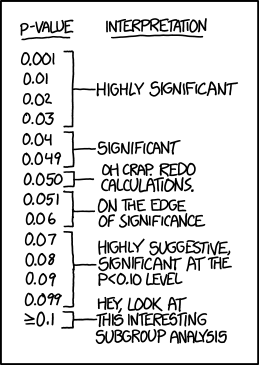(Thank you to Kevin J. McCann for pointing me to XKCD today.)
P.S. added 30-January-2015: Gigerenzer has a new article, extending the one linked above to Bayes factors. Links: http://jom.sagepub.com/content/41/2/421 and http://jom.sagepub.com/content/41/2/421.full.pdf+html Surrogate Science: The Idol of a Universal Method for Scientific Inference. Gerd Gigerenzer and Julian N. Marewski. Journal of Management, Vol. 41, No. 2, February 2015, 421–440.
In this article, we make three points.
1. There is no universal method of scientific inference but, rather, a toolbox of useful statistical methods. In the absence of a universal method, its followers worship surrogate idols, such as significant p values. The inevitable gap between the ideal and its surrogate is bridged with delusions—for instance, that a p value of 1% indicates a 99% chance of replication. These mistaken beliefs do much harm: among others, by promoting irreproducible results.
2. If the proclaimed “Bayesian revolution” were to take place, the danger is that the idol of a universal method might survive in a new guise, proclaiming that all uncertainty can be reduced to subjective probabilities. And the automatic calculation of significance levels could be revived by similar routines for Bayes factors. That would turn the revolution into a re-volution— back to square one.
These first two points are not “philosophical” but have very practical consequences, because
3. Statistical methods are not simply applied to a discipline; they change the discipline itself, and vice versa. In the social sciences, statistical tools have changed the nature of research, making inference its major concern and degrading replication, the minimization of measurement error, and other core values to secondary importance.

No comments:
Post a Comment